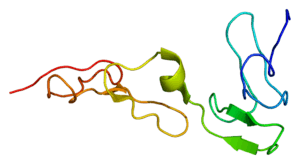Protein S deficiency
| Protein S deficiency | |
|---|---|
 | |
| Protein S | |
| Classification and external resources | |
| Specialty | hematology |
| ICD-10 | D68.5 |
| ICD-9-CM | 289.81 |
| OMIM | 176880 |
| DiseasesDB | 10814 |
| eMedicine | med/1924 |
| Patient UK | Protein S deficiency |
| MeSH | D018455 |
Protein S deficiency is a disorder associated with increased risk of venous thrombosis.[1]Protein S, a vitamin K-dependent physiological anticoagulant, acts as a nonenzymatic cofactor to activate protein C in the degradation of factor Va and factor VIIIa.[2] Decreased (antigen) levels or impaired function of protein S leads to decreased degradation of factor Va and factor VIIIa and an increased propensity to venous thrombosis. Protein S circulates in human plasma in two forms: approximately 60 percent is bound to complement component C4b β-chain while the remaining 40 percent is free, only free protein S has activated protein C cofactor activity
Types
There are three types of hereditary protein S deficiency:[3][4]
- Type I - decreased protein S activity: decreased total protein S levels,as well as decreased free protein S levels
- Type II- decreased in regards to the cofactor activity of the protein
- Type III -decreased protein S activity: decreased free protein S levels (normal total protein S levels)
Signs/symptoms
Among the possible presentation of protein S deficiency are:[1][3][5]
- Thrombosis of lower extremities
- Superficial thrombophlebitis
- Redness in affected area
- Purpura fulminans
Cause

In terms of the cause of protein S deficiency it can be in inherited via autosomal dominance.A mutation in the PROS1 gene triggers the condition. The cytogenetic location of the gene in question is chromosome 3, specifically 3q11.1[4][6] Protein S deficiency can also be acquired due to vitamin K deficiency, treatment with warfarin, liver disease, and acute thrombosis (antiphospholipid antibodies may also be a cause as well)[1]
Pathophysiology
In regards to the mechanism of protein S deficiency we should start by indicating that,Protein S is principally made in liver cells. Protein S is a cofactor of APC both work to degrade factor V and factor VIII.It has been suggested that Zn2+ might be necessary for Protein S binding to factor Xa.[3][7]
Mutations in this condition change amino acids, which in turn disrupts blood clotting. Functional protein S is lacking, which normally turns off clotting proteins, this increases risk of blood clots.[4]
Diagnosis
The diagnosis for deficiency of protein S can be done via reviewing family history of condition and genetic testing, as well as the following:[1][8][9]
- Protein S antigen test
- Coagulation test (prothrombin time test)
- Thrombotic disease investigation
- Factor V Leiden test
Differential diagnosis
Among the possibilities for differential diagnosis of protein S deficiency are- Antiphospholipid syndrome, disseminated intravascular coagulation and antithrombin deficiency (though this list is not exhaustive)[3]
Treatment

In terms of treatment for protein S deficiency the following are consistent with the management (and administration of) individuals with this condition ( it should be noted that the prognosis for inherited homozygotes is usually in line with a higher incidence of thrombosis for the affected individual[1]):[3][7]
- Unfractionated heparin (w/ warfarin)
- LMWH/Low molecular weight heparin
- Dabigatran
- Direct Factor Xa Inhibitors
- Graduated compressed stocking
- High degree of prophylaxis
References
- 1 2 3 4 5 "Protein S Deficiency. Learn about Protein S Deficiency | Patient". Patient. Retrieved 2016-10-16.
- ↑ "Protein S: Reference Range, Collection and Panels, Interpretation". 2016-06-01.
- 1 2 3 4 5 "Protein S Deficiency: Background, Pathophysiology, Epidemiology". 2016-05-02.
- 1 2 3 Reference, Genetics Home. "PROS1 gene". Genetics Home Reference. Retrieved 16 October 2016.
- ↑ "Congenital protein C or S deficiency: MedlinePlus Medical Encyclopedia". medlineplus.gov. Retrieved 16 October 2016.
- ↑ Reference, Genetics Home. "protein S deficiency". Genetics Home Reference. Retrieved 16 October 2016.
- 1 2 Ten Kate, M. K.; Van Der Meer, J. (1 November 2008). "Protein S deficiency: a clinical perspective". Haemophilia. 14 (6): 1222–1228. doi:10.1111/j.1365-2516.2008.01775.x. ISSN 1365-2516. Retrieved 16 October 2016.
- ↑ "Protein S blood test: MedlinePlus Medical Encyclopedia". medlineplus.gov. Retrieved 16 October 2016.
- ↑ "Protein S deficiency - Conditions - GTR - NCBI". www.ncbi.nlm.nih.gov. Retrieved 16 October 2016.
Further reading
- ten Kate M, Mulder R, Platteel M, Brouwer J, van der Steege G, van der Meer J (2006). "Identification of a novel PROS1 c.1113T-->GG frameshift mutation in a family with mixed type I/type III protein S deficiency". Haematologica. 91 (8): 1151–2. PMID 16885060.
- García de Frutos, Pablo; Fuentes-Prior, Pablo; Hurtado, Begoña; Sala, Núria (17 October 2007). "Molecular basis of protein S deficiency". Thrombosis and Haemostasis. doi:10.1160/TH07-03-0199. ISSN 0340-6245. Retrieved 16 October 2016.
- Wypasek, Ewa; Undas, Anetta (1 August 2016). "Protein C and protein S deficiency - practical diagnostic issues". Advances in Clinical and Experimental Medicine: Official Organ Wroclaw Medical University. 22 (4): 459–467. ISSN 1899-5276. PMID 23986205.